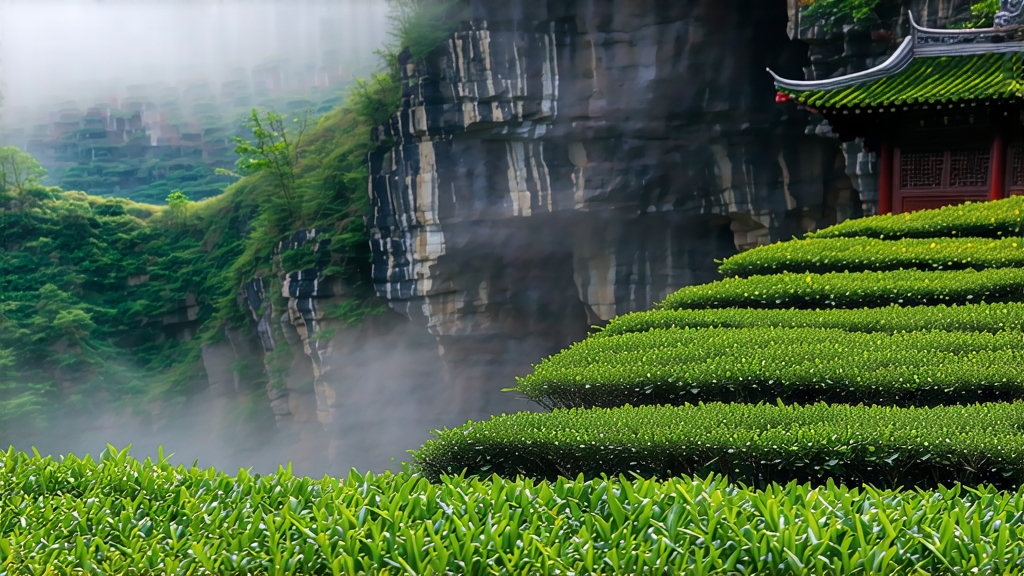
If green tea is the fresh-faced scholar of Chinese teas and pu-erh the venerable sage, then Da Hong Pao—literally “Big Red Robe”—is the warrior-poet: bold, fragrant, and layered with legend. Nestled in the mist-locked crevices of northern Fujian’s Wuyi Mountains, this oolong commands attention for its dramatic terroir, painstaking craft, and the lingering “rock rhyme” (yan yun) that connoisseurs chase the way musicians hunt for perfect resonance. To understand Da Hong Pao is to step into a 350-year-old saga of imperial taste, cliff-side horticulture, and fire-kissed leaves that still manage to taste like cool stone after eight infusions.
Legend first. In the late Ming dynasty, a scholar on his way to the capital exams fell gravely ill at the foot of Wuyi’s Nine-Dragon Gorge. Monks from a nearby temple brewed tea picked from four stately bushes clinging to the cliff; the restorative liquor revived him so completely that he went on to place first in the examinations. Returning in triumph, he draped his crimson imperial robe over the bushes to honor their gift—hence the name. Whether apocryphal or not, the tale secured those mother trees royal patronage; their leaves became tribute tea so precious that armed guards supposedly watched over each harvest. Today the original bushes—aged over 350 years—still stand, protected by UNESCO and the Chinese state. Commercial Da Hong Pao is no longer plucked from them; instead, cuttings (a technique called air-layering) have created genetically identical “qidan” and “beidou” gardens on the same rocky slopes, perpetuating the lineage while sparing the antiques.
Geology shapes flavor here more decisively than in any other tea region. The Wuyi range is a playground of weathered volcanic tuff and granite, flushed by mineral-rich springs and wrapped in fog that slows photosynthesis, thickening leaf cuticles and concentrating aromatics. Locals sum this up in the phrase “three cliffs, two gullies, one stream,” referring to the micro-valleys that collect cool air and reflect sunlight back onto the bushes. The resulting leaves are smaller, thicker, and waxier than lowland oolongs, storing sugars and polyphenols that will later transmute under charcoal fire into cocoa, orchid, and wet stone notes.
Craft begins the moment pickers—usually women wearing bamboo hats and hemp aprons—snap off the tender “zhong kai mian” (middle-open leaf) standard: three leaves and a bud, ideally picked between 9 a.m. and noon when dew has evaporated but sun is still soft. The harvest is rushed downhill in wicker baskets lined with banana leaves to prevent bruising. Inside the temple-like factory, the leaves are spread on bamboo trays and withered under natural draft for two hours, losing about 10 % moisture and softening cell walls. Next comes yao qing—“rocking green”—a uniquely Wuyi technique where the trays are stacked on a waist-high wooden rack and shaken rhythmically every 20 minutes for four to six hours. The gentle collisions tear marginal cells, jump-starting oxidation while the leaves remain whole. Mastery lies in reading the scent shift from cut grass to peach skin to white magnolia; one missed beat and the batch tips toward sourness.
When the leaf margins turn russet and the stems feel marshmallow-soft, the oxidized leaves are tumbled into dragon-eye-sized charcoal-fired ovens at 220 °C for three minutes—just long enough to kill the enzymes and lock in the crimson edges. But the signature of Da Hong Pao is its double charcoal roast. After a brief rest, the leaves are re-fired over a low ember heat (80–90 °C) for six to ten hours, depending on the master’s target: lighter roasts preserve floral top notes, while deeper roasts coax molasses, nutmeg, and a cooling menthol finish that locals call “rock bone.” The firing is done in woven rattan baskets nested inches above a pit of glowing hardwood embers; the master flips the baskets every 30 minutes, using bare palms to judge temperature—a skill passed father to son for thirteen generations in some families. After the final roast, the tea is rested for at least 60 days so residual charcoal smoke can mellow, yielding the prized “chen xiang” or aged fragrance.
Grading follows a sensory code known only to Wuyi insiders. Top-tier “Zhengyan